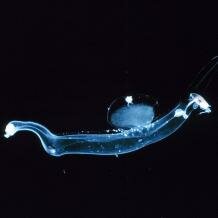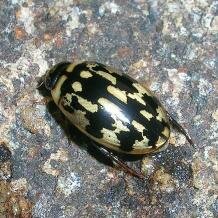Topic: Scanning eyes in molluscs and arthropods
Some sea snails have a linear retina. What a hopeless arrangement, to see the world through just a narrow slit! Not quite, because they have come up with a rather intriguing trick to extend their visual field - and it's a trick too good to use only once.
Some animals possess eyes with linear retinae (or similar linear receptor arrangements). Does this mean that they see the world through little more than a slit? Not really, because their eyes (or parts of them) can move and perform smooth scanning motions to enlarge their visual field. This capacity has evolved in at least four groups of animals from remarkably diverse phylogenetic backgrounds, all predators, and so presumably this scanning is related to prey capture. A potential disadvantage of scanning is that it can lead to motion blur and therefore decrease resolution, so it needs to be slow enough for the eye to extract information from the surroundings. It seems that the animals scan as fast as they can without losing spatial information, and scanning speeds are very similar across groups. This indicates that “all four groups of organisms have converged on the same optimal spatio-temporal sampling strategy, linked to the receptor response time” (Land et al. 1990, Journal of Comparative Physiology A, vol. 167, p. 166). Further parallels between the eyes in the different groups generally “suggest convergent evolution toward parameters specific to tubular scanning eyes” (Buschbeck et al. 2007, Journal of Comparative Physiology A, vol. 193, p. 981).
Heteropod molluscs
 Heteropods (Pterotracheoidea) are carnivorous marine snails adapted to a life in the water column. Their camera eyes are unusually large and complex for gastropods and distinctive in that the retina is a long narrow ribbon, either straight or curved. In Oxygyrus keraudreni, for example, it is merely three receptors wide and about 410 receptors long. The problem of the resulting narrow field of view is solved by scanning movements perpendicular to the retina’s long dimension, during which the eyes are rapidly rotated downwards (with the retina moving up and the lens down) and then slowly return to their original position. It has been suggested that scanning aids the detection of small prey organisms glinting against the dark abyss of the sea.
Heteropods (Pterotracheoidea) are carnivorous marine snails adapted to a life in the water column. Their camera eyes are unusually large and complex for gastropods and distinctive in that the retina is a long narrow ribbon, either straight or curved. In Oxygyrus keraudreni, for example, it is merely three receptors wide and about 410 receptors long. The problem of the resulting narrow field of view is solved by scanning movements perpendicular to the retina’s long dimension, during which the eyes are rapidly rotated downwards (with the retina moving up and the lens down) and then slowly return to their original position. It has been suggested that scanning aids the detection of small prey organisms glinting against the dark abyss of the sea.
Jumping spiders
 The eight camera-type eyes of jumping spiders (Salticidae) endow these hunters with remarkably acute vision. Six of them – two rudimentary and four fixed to the carapace – are conventional eyes that detect motion. The large pair of tubular anterior median eyes, however, is rather more unusual. In both these eyes, the retina is a narrow boomerang-shaped strip oriented vertically. Its central region, where acuity is highest, is merely six or seven receptor rows wide. As the lens is anchored to the carapace, the retina needs to be moved for scanning, which is achieved by a set of muscles that orchestrate a complicated pattern of translations and rotations. Furthermore, the retina possesses a highly complex ultrastructure. Not only does a characteristic pit magnify the image (resulting in a telephoto eye), but the retina also consists of up to four layers of receptors. It has been suggested that this layered structure allows objects at different distances to be focussed at different levels, or different wavelengths to be focussed on receptor layers that are particularly sensitive to them. The scanning movements that direct the retina across a target seem to be related to pattern recognition, distinguishing potential mates from prey.
The eight camera-type eyes of jumping spiders (Salticidae) endow these hunters with remarkably acute vision. Six of them – two rudimentary and four fixed to the carapace – are conventional eyes that detect motion. The large pair of tubular anterior median eyes, however, is rather more unusual. In both these eyes, the retina is a narrow boomerang-shaped strip oriented vertically. Its central region, where acuity is highest, is merely six or seven receptor rows wide. As the lens is anchored to the carapace, the retina needs to be moved for scanning, which is achieved by a set of muscles that orchestrate a complicated pattern of translations and rotations. Furthermore, the retina possesses a highly complex ultrastructure. Not only does a characteristic pit magnify the image (resulting in a telephoto eye), but the retina also consists of up to four layers of receptors. It has been suggested that this layered structure allows objects at different distances to be focussed at different levels, or different wavelengths to be focussed on receptor layers that are particularly sensitive to them. The scanning movements that direct the retina across a target seem to be related to pattern recognition, distinguishing potential mates from prey.
Crustaceans
 A number of crustaceans have also evolved scanning. Mantis shrimps (Stomatopoda) are visually guided predators with very unusual eyes. As in jumping spiders, the retina is layered, with different layers containing different visual pigments (including some absorbing ultraviolet light). However, the colour vision system resides in only a central band of enlarged facets that is embedded in am otherwise conventional compound eye. Whilst the central band has a linear, basically one-dimensional field of view, the visual field of the rest of the eye is larger and two-dimensional. The band should therefore move slowly to allow scanning and colour vision outside a very narrow strip, while the rest should move quickly between stationary fixations to enable image stabilisation. How is this conflict solved? It seems that the different systems do not operate simultaneously but alternately, resulting in a remarkably complex repertoire of eye movements that give the shrimps an almost primate-like, inquisitive appearance.
A number of crustaceans have also evolved scanning. Mantis shrimps (Stomatopoda) are visually guided predators with very unusual eyes. As in jumping spiders, the retina is layered, with different layers containing different visual pigments (including some absorbing ultraviolet light). However, the colour vision system resides in only a central band of enlarged facets that is embedded in am otherwise conventional compound eye. Whilst the central band has a linear, basically one-dimensional field of view, the visual field of the rest of the eye is larger and two-dimensional. The band should therefore move slowly to allow scanning and colour vision outside a very narrow strip, while the rest should move quickly between stationary fixations to enable image stabilisation. How is this conflict solved? It seems that the different systems do not operate simultaneously but alternately, resulting in a remarkably complex repertoire of eye movements that give the shrimps an almost primate-like, inquisitive appearance.
In most copepods, the eyes are small and immobile, but some groups have larger, better-developed eyes that are often movable. Two copepods possess narrow retinae and perform scanning movements. The tiny retina of Copilia scans laterally across the visual field of a single large lens. Male Labidocera have dorsal eyes with a large spherical lens, beneath which lies an eyecup with eight receptors. Five of these receptors are arranged in a line and the two eyecups are joined to form a linear retina of ten receptors. The retina’s field of view would be about 40° long and 4° wide but is extended through scanning. As the eyes of females are different, it has been suggested that the function of scanning is the localisation of potential mates.
Dytiscid diving beetles
 The larvae of the sunburst diving beetle (Thermonectus marmoratus) are effective predators that track their prey visually before striking. Like larvae of other holometabolic insects, they do not have compound eyes but several so-called stemmata, which are small lens eyes. On each side of the head, there are six stemmata, two of which are the principal eyes for prey capture (the peripheral eyes probably aid the localisation of prey, like in jumping spiders). These tubular principal eyes are unusual in that each eye contains two different retinae that together form a narrow horizontal band at the proximal end (similar to the tubular eyes with layered retinae in jumping spiders). However, these beetle larvae cannot move their eyes or part of them, so how do they achieve the scanning motion? They perform pivoting movements of the head and thorax prior to prey capture and thus extend their vertical visual field behaviourally (by about an order of magnitude). Interestingly, this always seems to happen at a particular distance to their prey, implying that the extent to which the visual field is extended depends on distance. A potential disadvantage of this body scanning is that the resulting water movements could be detected by potential predators or prey. Furthermore, the scan speed is slower than in other scanning animals and possibly limited by the inertia of the body.
The larvae of the sunburst diving beetle (Thermonectus marmoratus) are effective predators that track their prey visually before striking. Like larvae of other holometabolic insects, they do not have compound eyes but several so-called stemmata, which are small lens eyes. On each side of the head, there are six stemmata, two of which are the principal eyes for prey capture (the peripheral eyes probably aid the localisation of prey, like in jumping spiders). These tubular principal eyes are unusual in that each eye contains two different retinae that together form a narrow horizontal band at the proximal end (similar to the tubular eyes with layered retinae in jumping spiders). However, these beetle larvae cannot move their eyes or part of them, so how do they achieve the scanning motion? They perform pivoting movements of the head and thorax prior to prey capture and thus extend their vertical visual field behaviourally (by about an order of magnitude). Interestingly, this always seems to happen at a particular distance to their prey, implying that the extent to which the visual field is extended depends on distance. A potential disadvantage of this body scanning is that the resulting water movements could be detected by potential predators or prey. Furthermore, the scan speed is slower than in other scanning animals and possibly limited by the inertia of the body.
Cite this web page
Map of Life - "Scanning eyes in molluscs and arthropods"
https://mapoflife.org/topics/topic_281_scanning-eyes-in-molluscs-and-arthropods/
April 29, 2021

